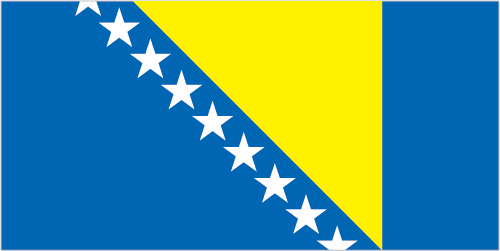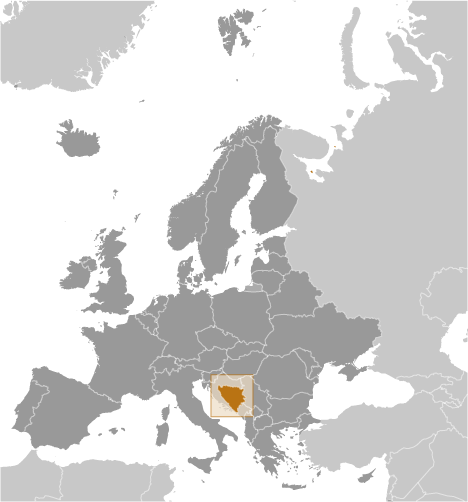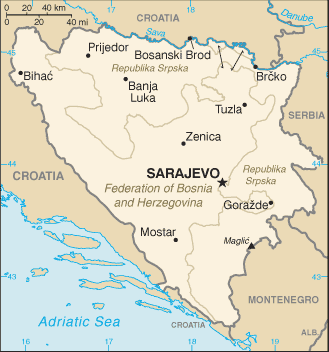|
Country name:
|

|
|
conventional long form: none
conventional short form:
Bosnia and Herzegovina
local long form:
none
local short form:
Bosna i Hercegovina
former:
People's Republic of Bosnia and Herzegovina, Socialist Republic of Bosnia and Herzegovina
|
|
|
Government type:
|

|
|
emerging federal democratic republic
|
|
|
Capital:
|

|
|
name: Sarajevo
geographic coordinates:
43 52 N, 18 25 E
time difference:
UTC+1 (6 hours ahead of Washington, DC during Standard Time)
daylight saving time:
+1hr, begins last Sunday in March; ends last Sunday in October
|
|
|
Administrative divisions:
|

|
|
2 first-order administrative divisions and 1 internationally supervised district* - Brcko District (Brcko Distrikt)*, the Bosniak/Croat Federation of Bosnia and Herzegovina (Federacija Bosne i Hercegovine) and the Bosnian Serb-led Republika Srpska; note - Brcko District is in northeastern Bosnia and is a self-governing administrative unit under the sovereignty of Bosnia and Herzegovina and formally held in condominium between the two entities
|
|
|
Independence:
|

|
|
1 March 1992 (from Yugoslavia; referendum for independence completed on 1 March 1992; independence declared on 3 March 1992)
|
|
|
National holiday:
|

|
|
National Day (Statehood Day), 25 November (1943); note - observed only in the Federation of Bosnia and Herzegovina entity
|
|
|
Constitution:
|

|
|
the Dayton Peace Accords, signed 14 December 1995 in Paris, included a constitution; note - each of the entities and cantons also has its own constitution
|
|
|
Legal system:
|

|
|
civil law system; Constitutional Court review of legislative acts
|
|
|
International law organization participation:
|

|
|
has not submitted an ICJ jurisdiction declaration; accepts ICCt jurisdiction
|
|
|
Suffrage:
|

|
|
18 years of age, 16 if employed; universal
|
|
|
Executive branch:
|

|
|
chief of state: Chairman of the Presidency Nebojsa RADMANOVIC (chairman since November 2012; presidency member since 6 November 2006 - Serb); other members of the three-member presidency rotate every eight months: Bakir IZETBEGOVIC (presidency member since 10 November 2010 - Bosniak); Zeljko KOMSIC (presidency member since 6 November 2006 - Croat)
head of government:
Chairman of the Council of Ministers Vjekoslav BEVANDA (since 12 January 2012)
cabinet:
Council of Ministers nominated by the council chairman; approved by the state-level House of Representatives
(For more information visit the World Leaders website  ) )
elections:
the three members of the presidency (one Bosniak, one Croat, one Serb) elected by popular vote for a four-year term (eligible for a second term, but then ineligible for four years) by constituencies referring to the three ethnic groups; the candidate with the most votes in a constituency is elected; the chairmanship rotates every eight months and resumes where it left off following each general election; election last held on 3 October 2010 (next to be held in October 2014); the chairman of the Council of Ministers appointed by the presidency and confirmed by the state-level House of Representatives
election results:
percent of vote - Nebojsa RADMANOVIC with 48.9% of the votes for the Serb seat; Zeljko KOMSIC with 60.6% of the votes for the Croat seat; Bakir IZETBEGOVIC with 34.9% of the votes for the Bosniak seat
note:
President of the Federation of Bosnia and Herzegovina: Zivko BUDIMIR (since 17 March 2011); Vice Presidents Spomenka MICIC (since 21 February 2007) and Mirsad KEBO (since 21 February 2007); President of the Republika Srpska: Milorad DODIK (since 15 November 2010)
|
|
|
Legislative branch:
|

|
|
bicameral Parliamentary Assembly or Skupstina consists of the House of Peoples or Dom Naroda (15 seats, 5 Bosniak, 5 Croat, 5 Serb; members designated by the Bosniak/Croat Federation's House of Peoples and the Republika Srpska's National Assembly to serve four-year terms); and the state-level House of Representatives or Predstavnicki Dom (42 seats, 28 seats allocated for the Federation of Bosnia and Herzegovina and 14 seats for the Republika Srpska; members elected by popular vote on the basis of proportional representation to serve four-year terms); note - Bosnia's election law specifies four-year terms for the state and first-order administrative division entity legislatures
elections:
House of Peoples - last constituted in 9 June 2011 (next likely to be constituted in 2015); state-level House of Representatives - elections last held on 3 October 2010 (next to be held in October 2014)
election results:
House of Peoples - percent of vote by party/coalition - NA; seats by party/coalition - NA; state-level House of Representatives - percent of vote by party/coalition - NA; seats by party/coalition - SDP BiH 8, SNSD 8, SDA 7, SDS 4, SBBBiH 4, HDZ-BiH 3, SBiH 2, HDZ-1990/HSP 2, other 4
note:
the Bosniak/Croat Federation has a bicameral legislature that consists of a House of Peoples (58 seats - 17 Bosniak, 17 Croat, 17 Serb, 7 other); last constituted May 2011 (next likely to be constituted in 2015); and a House of Representatives (98 seats; members elected by popular vote to serve four-year terms); elections last held on 3 October 2010 (next to be held in October 2014); percent of vote by party - NA; seats by party/coalition - SDP 28, SDA 23, SBBBiH 13, HDZ-BiH 12, SBiH 9, HDZ-1990/HSP 5, NSRzB 5, other 3; the Republika Srpska has a National Assembly (83 seats; members elected by popular vote to serve four-year terms); elections last held on 3 October 2010 (next to be held in October 2014); percent of vote by party - NA; seats by party/coalition - SNSD 37, SDS 18, PDP 7, DNS 6, SP 4, DP 3, SDP 3, SDA 2, NDS 2 SRS-RS 1; as a result of the 2002 constitutional reform process, a 28-member Republika Srpska Council of Peoples (COP) was established in the Republika Srpska National Assembly including 8 Croats, 8 Bosniaks, 8 Serbs, and 4 members of the smaller communities
|
|
|
Judicial branch:
|

|
|
BiH Constitutional Court (consists of nine members: four members are selected by the Bosniak/Croat Federation's House of Representatives, two members by the Republika Srpska's National Assembly, and three non-Bosnian members by the president of the European Court of Human Rights); BiH State Court (consists of 54 judges and has three divisions - Administrative, Appellate and Criminal - having jurisdiction over cases related to state-level law and cases initiated in the entities that question BiH's sovereignty, political independence, or national security or with economic crimes that have serious repercussions for BiH's economy, beyond that of an entity or Brcko District); a War Crimes Chamber opened in March 2005
note:
the entities each have a Constitutional Court; each entity also has a number of lower courts; there are 10 cantonal courts in the Federation, plus a number of municipal courts; the Republika Srpska has five district courts and a number of municipal courts
|
|
|
Political parties and leaders:
|

|
|
Alliance for a Better Future of BiH or SBB-BiH [Fahrudin RADONCIC]; Alliance of Independent Social Democrats or SNSD [Milorad DODIK]; Bosnian Party or BOSS [Mirnes AJANOVIC]; Bosnian Patriotic Party or BPS [Sefer HALILOVIC]; Civic Democratic Party or GDS [Ibrahim SPAHIC]; Croat Party of Rights or HSP [Zvonko JURISIC]; Croat Peasants' Party-New Croat Initiative or HSS-NHI [Ante COLAK]; Croatian Christian Democratic Union of Bosnia and Herzegovina or HKDU [Ivan MUSA]; Croatian Democratic Union of Bosnia and Herzegovina or HDZ-BiH [Dragan COVIC]; Croatian Democratic Union 1990 or HDZ-1990 [Bozo LJUBIC]; Croatian Peoples Union [Milenko BRKIC]; Democratic National Union or DNZ [Rifat DOLIC]; Democratic Party or DP [Dragan CAVIC]; Democratic Peoples' Alliance or DNS [Marko PAVIC]; Liberal Democratic Party or LDS [Bojan Zec FILIPOVIC]; Nasa Stranka or NS [Denis GRATZ]; New Socialist Party or NSP [Zdravko KRSMANOVIC]; Party for Bosnia and Herzegovina or SBiH [Amer JERLAGIC]; Party of Democratic Action or SDA [Sulejman TIHIC]; Party of Democratic Progress or PDP [Mladen IVANIC]; 'People's' Party of Work for Progress or NSRzB [Mladen IVANKOVIC-LIJANOVIC]; Serb Democratic Party or SDS [Mladen BOSIC]; Serb Radical Party of the Republika Srpska or SRS-RS [Milanko MIHAJLICA]; Serb Radical Party-Dr. Vojislav Seselj or SRS-VS [Mirko BLAGOJEVIC]; Social Democratic Party of BiH or SDP BiH [Zlatko LAGUMDZIJA]; Social Democratic Union or SDU [Nermin PECANAC]; Socialist Party of Republika Srpska or SPRS [Petar DJOKIC]
|
|
|
Political pressure groups and leaders:
|

|
|
other: war veterans; displaced persons associations; family associations of missing persons; private media
|
|
|
International organization participation:
|

|
|
BIS, CD, CE, CEI, EAPC, EBRD, FAO, G-77, IAEA, IBRD, ICAO, ICC (NGOs), ICRM, IDA, IFAD, IFC, IFRCS, ILO, IMF, IMO, IMSO, Interpol, IOC, IOM, IPU, ISO, ITSO, ITU, ITUC (NGOs), MIGA, MONUSCO, NAM (observer), OAS (observer), OIC (observer), OIF (observer), OPCW, OSCE, PFP, SELEC, UN, UNCTAD, UNESCO, UNIDO, UNWTO, UPU, WCO, WHO, WIPO, WMO, WTO (observer)
|
|
|
Diplomatic representation in the US:
|

|
|
chief of mission: Ambassador Jadranka NEGODIC
chancery:
2109 E Street NW, Washington, DC 20037
telephone:
[1] (202) 337-1500
FAX:
[1] (202) 337-1502
consulate(s) general:
Chicago, New York
|
|
|
Diplomatic representation from the US:
|

|
|
chief of mission: Ambassador Patrick S. MOON
embassy:
1 Robert C. Frasure Street, 71000 Sarajevo
mailing address:
use embassy street address
telephone:
[387] (33) 704-000
FAX:
[387] (33) 659-722
branch office(s):
Banja Luka, Mostar
|
|
|
Flag description:
|

|
|
a wide medium blue vertical band on the fly side with a yellow isosceles triangle abutting the band and the top of the flag; the remainder of the flag is medium blue with seven full five-pointed white stars and two half stars top and bottom along the hypotenuse of the triangle; the triangle approximates the shape of the country and its three points stand for the constituent peoples - Bosniaks, Croats, and Serbs; the stars represent Europe and are meant to be continuous (thus the half stars at top and bottom); the colors (white, blue, and yellow) are often associated with neutrality and peace, and traditionally are linked with Bosnia
|
|
|
National symbol(s):
|

|
|
golden lily
|
|
|
National anthem:
|

|
|
name: "Drzavna himna Bosne i Hercegovine" (The National Anthem of Bosnia and Herzegovina)
lyrics/music:
Dusan SESTIC and Benjamin ISOVIC/Dusan SESTIC
note:
music adopted 1999; lyrics adopted 2009
|
|
|
|
|





 )
)



